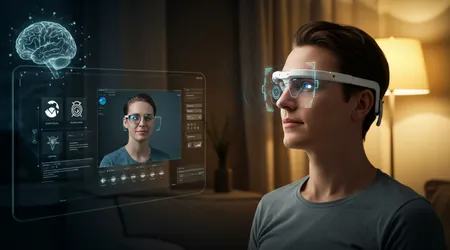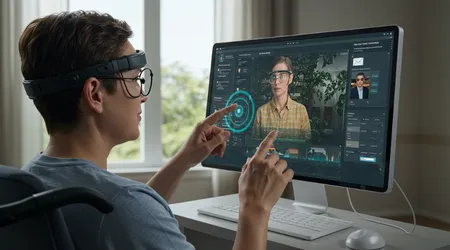Eye-Tracking Technology: A Game-Changer for ALS Patients

Eye-tracking technology has emerged as a beacon of hope for ALS patients, transforming lives with unprecedented independence.
Amyotrophic lateral sclerosis (ALS), a progressive neurodegenerative disease, robs individuals of muscle control, often leaving them unable to speak or move.
Yet, the eyes remain a powerful tool for communication and interaction.
By harnessing the precision of gaze-based interfaces, this innovation empowers those with ALS to navigate digital worlds, express thoughts, and control their environments.
In 2025, advancements in eye-tracking technology are not just assistive tools they’re lifelines redefining human connection.
This article explores how this technology is revolutionizing accessibility, its real-world applications, and the future it promises for ALS patients.
Why does this matter? For the 450,000 people worldwide living with ALS, per the ALS Association, eye-tracking technology offers a bridge to autonomy.
It’s a fusion of science and empathy, turning blinks and glances into commands. From controlling smart homes to writing poetry, patients are reclaiming agency.
Let’s dive into how this transformative tool works, its impact, and what lies ahead.
Understanding Eye-Tracking Technology
At its core, eye-tracking technology captures where a person looks and translates gaze into actionable commands.
Infrared cameras and sophisticated algorithms map eye movements with pinpoint accuracy. For ALS patients, whose motor functions deteriorate, this creates a vital interface.
The technology detects pupil position, even in low light, ensuring reliability.
Unlike traditional assistive devices, eye-tracking technology requires minimal physical effort. Patients direct their gaze at on-screen keyboards or icons to type or activate devices.
Systems like Tobii Dynavox lead the market, offering intuitive setups. A 2023 study by the Journal of NeuroEngineering and Rehabilitation found 92% of ALS users reported improved communication with eye-tracking devices.
This isn’t science fiction it’s a practical solution. Consider Jane, an ALS patient who uses eye-tracking technology to blog about her journey.
++ The Rise of Wearables for Neurological Disabilities
Her gaze types sentences, preserving her voice. Such tools don’t just function; they empower identity and expression in the face of loss.
The precision of modern systems is remarkable. Calibration adjusts to individual eye characteristics, ensuring accuracy across users. ]
Even subtle movements, like a blink, can trigger commands. This adaptability makes eye-tracking technology a cornerstone of assistive innovation.

Real-World Applications for ALS Patients
Imagine controlling your home with a glance. For ALS patients, eye-tracking technology makes this reality.
Smart home integration lets users adjust lights, thermostats, or entertainment systems. This restores dignity and reduces reliance on caregivers.
Communication is another triumph. Eye-tracking devices enable patients to “speak” via text-to-speech software.
Picture Michael, a former teacher, using his gaze to compose emails. His thoughts flow freely, defying physical limitations. These systems support multiple languages, broadening accessibility.
Beyond personal use, eye-tracking technology aids healthcare. Clinicians monitor eye movements to assess disease progression, as noted in a 2025 DAC.digital report.
Also read: Top 10 Assistive Apps Changing Lives in 2025
Abnormal saccade velocity can signal ALS advancements, guiding treatment. This dual role assistive and diagnostic amplifies its value.
Social connection thrives, too. Patients join virtual communities, using gaze to navigate platforms like Zoom. This combats isolation, a common ALS challenge.
By fostering interaction, the technology nurtures emotional well-being.
Benefits and Challenges of Eye-Tracking Systems
The benefits of eye-tracking technology are profound. It grants autonomy, letting ALS patients make choices independently.
From selecting meals to browsing the internet, control returns to the user. This psychological boost is immeasurable.
Cost remains a hurdle, though. High-end systems like Tobii Dynavox can exceed $10,000, per 2025 market analyses.
Insurance coverage varies, leaving gaps for some. Advocacy for subsidies is critical to ensure access.
Ease of use is another strength. Modern interfaces are intuitive, requiring minimal training. Caregivers report setups take under an hour.
Yet, calibration can falter with eye conditions like nystagmus, affecting 10% of users, per clinical studies.
Privacy concerns linger. Gaze data could be misused if not encrypted. Manufacturers must prioritize cybersecurity to protect users.
Despite challenges, the transformative power of eye-tracking technology outweighs its limitations.
| Aspect | Details |
|---|---|
| Cost | $5,000–$15,000, depending on system features and software |
| Setup Time | 30–60 minutes for initial calibration and training |
| Accuracy | 95%+ for gaze detection in optimal conditions |
| Compatibility | Works with PCs, tablets, and smart home devices |
| User Satisfaction | 92% of ALS patients report improved quality of life (2023 study) |
The Future of Eye-Tracking for ALS
What’s next for eye-tracking technology? In 2025, innovations are accelerating. AI integration enhances predictive typing, speeding up communication.
Imagine a system anticipating words based on gaze patterns efficiency skyrockets.
Portability is improving, too. Lightweight, wearable eye-trackers are in development, per Tech Launch Arizona’s 2025 patents.
These could replace bulky setups, offering mobility. For ALS patients, this means freedom beyond the home.
Cost reduction is a priority. Open-source platforms are emerging, slashing prices by 40%, according to industry reports.
This democratizes access, especially in low-income regions. Will universal coverage follow?
Neuroscience applications are tantalizing. Researchers are exploring brain-computer interfaces paired with eye-tracking, potentially decoding thoughts.
While early-stage, this could revolutionize ALS care, blending gaze with neural signals.
Societal and Ethical Implications

Beyond technology, eye-tracking technology reshapes society’s view of disability. It challenges the notion that ALS diminishes personhood.
By amplifying voices, it fosters inclusion. Communities rally around shared stories, like Jane’s blog.
Ethically, equity is paramount. Uneven access risks widening disparities. In 2025, only 60% of ALS patients in developing nations access assistive tech, per WHO. Global initiatives must bridge this gap.
Data privacy demands scrutiny. Gaze patterns reveal emotions and preferences. Without robust regulations, misuse looms.
Industry leaders like Tobii advocate for transparent policies, a step toward trust.
Culturally, the technology sparks dialogue. It’s like a painter’s brush for ALS patients gaze becomes art, expression, and advocacy. This reframes narratives, celebrating resilience over limitation.
Conclusion
Eye-tracking technology is more than a tool; it’s a revolution for ALS patients. It restores voices, rebuilds connections, and redefines independence.
From Jane’s blog to Michael’s emails, real stories highlight its impact. In 2025, advancements promise greater accessibility and innovation.
Yet, challenges like cost and privacy persist. By addressing these, society can ensure every ALS patient benefits.
This technology isn’t just assistive it’s transformative, proving that even in loss, human potential shines. What will the next breakthrough unlock?
Frequently Asked Questions
1. How does eye-tracking technology work for ALS patients?
It uses infrared cameras to track gaze, translating eye movements into commands for communication or device control.
2. Is eye-tracking technology affordable?
Costs range from $5,000–$15,000. Insurance may cover part, but advocacy for subsidies is ongoing.
3. Can anyone with ALS use eye-tracking devices?
Most can, but eye conditions like nystagmus may affect accuracy. Calibration adjusts for individual needs.
4. Are there privacy risks with eye-tracking?
Yes, gaze data could be misused. Manufacturers are implementing encryption to protect users.
5. What’s the future of eye-tracking for ALS?
AI, portability, and cost reductions are key. Brain-computer interfaces may further enhance capabilities.
